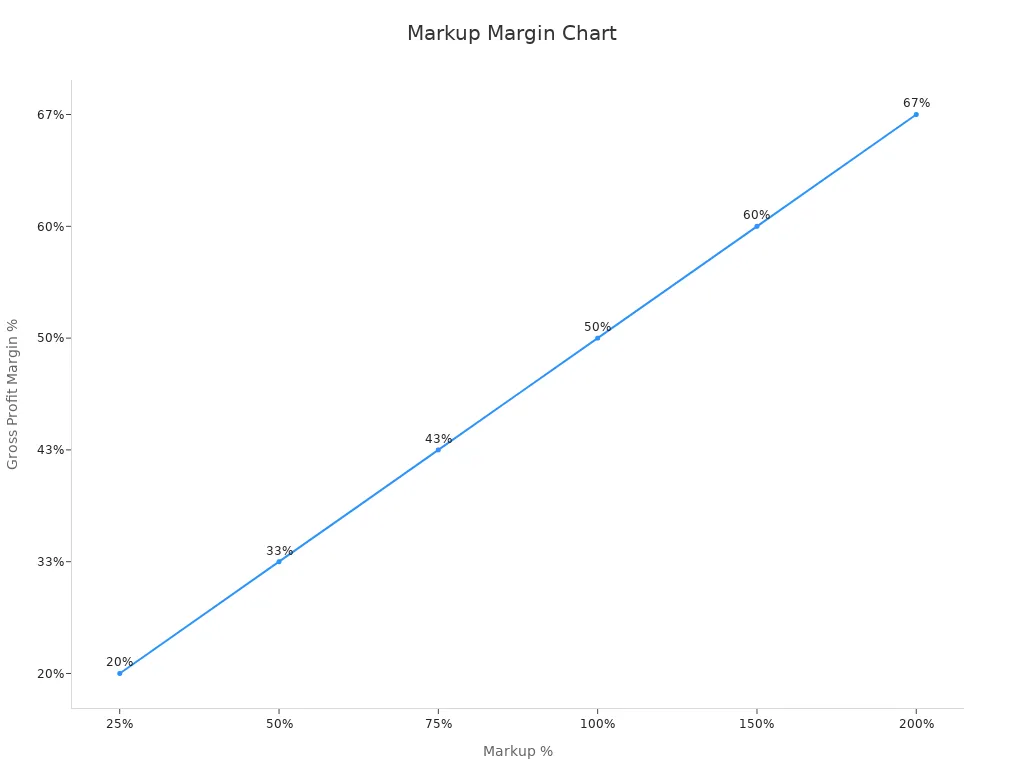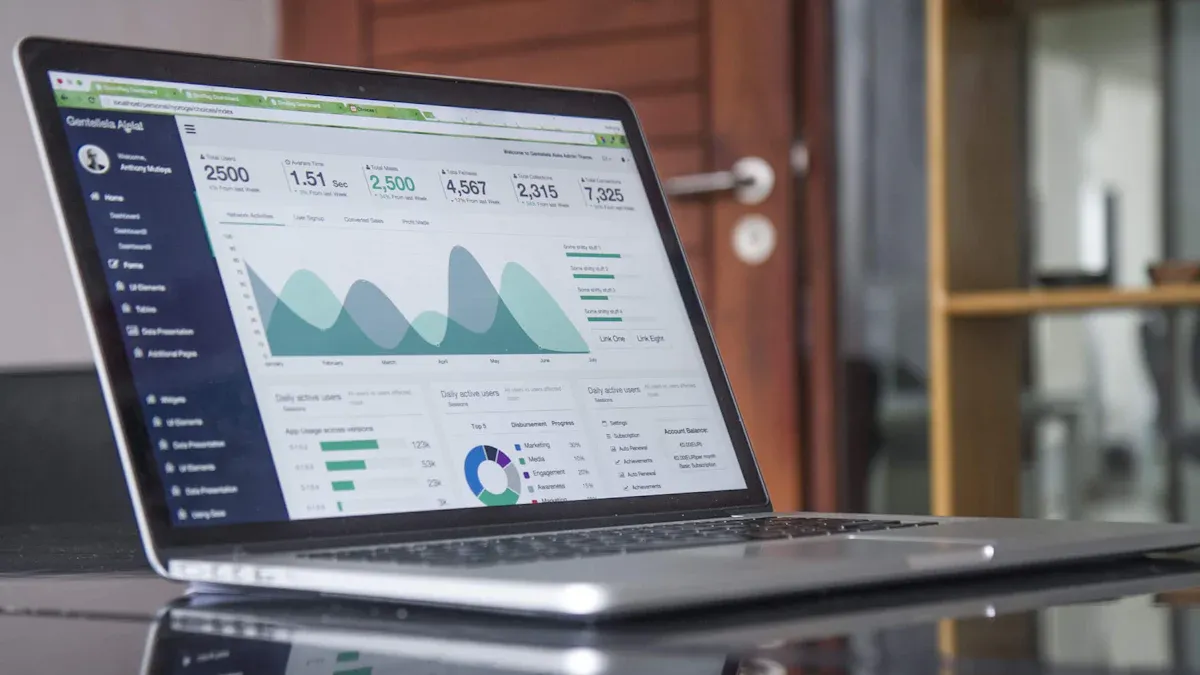How to Identify High-Profit Margin Wholesale Products for Your Business

You can identify high-profit margin wholesale products by examining costs, market demand, competition, and using data-driven tools. A high-profit margin product gives you strong financial flexibility and supports business growth. Many wholesale businesses compare their product margins to industry benchmarks, aiming for a 50% profit margin to stay competitive. Wholesale profit margins often reflect how well you manage variable costs like shipping and packaging. Tracking these numbers helps you choose wholesale products that deliver the best profit, even as demand and competition shift throughout the year.
Key Takeaways
Aim for a profit margin of at least 50% by using industry benchmarks and pricing formulas to set competitive wholesale prices.
Choose high-margin products like niche, specialty, evergreen, and trending items to balance steady income and quick profits.
Research market demand and competition carefully using tools like Google Trends to find products with strong sales and moderate competition.
Compare supplier prices and check product quality to negotiate better deals and maintain customer satisfaction.
Test new products in small batches and focus on customer retention to boost profits and build a loyal customer base.
Profit Margin Goals
Industry Benchmarks
You need to understand wholesale profit margin goals before you set wholesale prices for your business. Most successful companies use industry benchmarks to measure their performance. Wholesale pricing methods often rely on these benchmarks to guide decisions. For example, high-margin products in wholesale sectors usually deliver an estimated profit margin range of 55% to 70%. This is much higher than the industry average, which often falls between 30% and 40%.
Tip: Benchmarking your wholesale margins against competitors helps you spot areas for improvement and stay competitive.
You can see how different wholesale sectors compare in the table below:
Wholesale Sector | Avg. Gross Profit Margin | Avg. Net Profit Margin |
|---|---|---|
Food Wholesalers | ~14.9% | ~1.2% |
Retail (Distributors) | ~32.3% | ~7.6% |
Retail (Grocery and Food) | ~25.5% | ~1.2% |
Auto Parts | ~15.0% | ~1.6% |
Tracking profit margins over time and comparing them with these benchmarks gives you a clear picture of your business’s profitability. You can use this data to adjust your wholesale pricing and improve your estimated profit margin range.
Margin Calculation
You must know how to calculate wholesale prices to achieve your profit goals. The most common wholesale pricing formula is:
(Retail Price – Cost) ÷ Retail Price = Gross Profit Margin
This formula helps you measure how much profit you keep from each sale after covering the cost of goods sold. For example, if you buy a product for $10 and sell it for $15, your markup is 50%. The gross profit margin is 33%. This matches the standard 50% markup guideline used in wholesale pricing.
Markup % | Gross Profit Margin % |
|---|---|
25% | 20% |
50% | 33% |
75% | 43% |
100% | 50% |
150% | 60% |
200% | 67% |
You can see from the table that a 100% markup (keystone pricing) gives you a 50% gross profit margin. Many wholesale businesses use this method to set wholesale prices and maintain strong wholesale margins.
Let’s look at a real-world example. Suppose you make violins. Each violin costs $600 to produce. You sell each one for $1,000. If you sell 100 violins, your total revenue is $100,000. Your total cost is $60,000. Your gross profit is $40,000. The gross profit margin is 40%. This means for every $1 you earn, $0.40 is profit after covering direct costs.
Description | Value | Calculation | Result |
|---|---|---|---|
Cost to make one violin | $600 | N/A | N/A |
Selling price per violin | $1,000 | N/A | N/A |
Number of violins sold | 100 | N/A | N/A |
Total revenue | $100,000 | 100 violins x $1,000 | $100,000 |
Total cost of goods sold | $60,000 | 100 violins x $600 | $60,000 |
Gross profit | $40,000 | $100,000 - $60,000 | $40,000 |
Gross profit margin formula | [(Revenue - COGS) / Revenue] x 100 | [($100,000 - $60,000) / $100,000] x 100 | 40% |
Interpretation | For every $1 earned, $0.40 is profit after covering direct costs | N/A | N/A |
You can also use this approach to calculate wholesale prices for other products. For example, if a swimsuit costs $15 to make and you use a wholesale price of $30, your margin is 50%. If you sell it at retail for $75, your margin jumps to 60%. Direct-to-consumer sales can push the margin even higher, sometimes up to 80%.
Item | Cost of Goods Sold (COGS) | Price | Margin Calculation | Margin % |
|---|---|---|---|---|
Swimsuit | $15 | Wholesale: $30 | (Wholesale Price - COGS) / Wholesale Price | 50% |
Retail: $75 | (Retail Price - Wholesale Price) / Retail Price | 60% | ||
Direct to Consumer (DTC): $75 | (Retail Price - COGS) / Retail Price | 80% | ||
Wholesale pricing strategy | N/A | Wholesale price = 2 x COGS | Ensures at least 50% gross profit margin | ≥50% |
Industry target margins | N/A | N/A | Apparel wholesale margin target range | 30%-50% |
N/A | Direct-to-consumer margin target range | 55%-65% |
Note: High-margin products in wholesale often reach an estimated profit margin range of 55% to 70%. This is well above the average for most industries.
You should always calculate wholesale prices using these formulas to ensure your wholesale profit margin meets your business goals. Wholesale pricing methods like keystone pricing help you set wholesale prices that maximize profitability. Understanding wholesale margins and calculating wholesale margins regularly will help you stay ahead in the market.

Tracking your profit margin, ROI, and other metrics over time will help you measure your business’s success. You can use these numbers to adjust your wholesale pricing and improve your estimated profit margin range. When you set wholesale prices with a clear goal, you build a strong foundation for long-term profitability.
High-Profit Product Types

Choosing the right high-profit product types for your wholesale business can set you apart from competitors. You want to focus on high-margin products that offer both strong demand and reliable profits. Wholesale product lists often include a mix of niche, specialty, evergreen, and trending items. Understanding these categories helps you build a wholesale product list that maximizes your returns.
Niche and Specialty
Niche and specialty products stand out in wholesale product lists because they target specific customer groups. These products often have higher prices and face less competition. You can find high-margin products in categories like collectibles, luxury apparel, and children's products. The table below shows how different wholesale product types compare in terms of gross margin and key considerations:
Product Category | Typical Gross Margin Range | Key Profitability Considerations |
|---|---|---|
Luxury Apparel | 50-70% | Highest margin potential |
Collectibles | 60-80%+ | Requires authentication expertise |
Children's Products | 45-65% | Quick turnover balances lower margins |
Furniture | 40-60% | Space costs impact profits |
Electronics | 30-50% | Depreciation requires quick sales |
Niche markets let you build strong brand loyalty and community. You can maintain premium pricing and stable margins because you face less direct competition. Wholesale product lists with niche items often outperform mainstream products in margin performance. You also benefit from passionate customer bases and lower price sensitivity.
Tip: Use online research tools like Google Trends and eBay Completed Listings to spot high-demand products for your wholesale product list. Look for products with low price elasticity and strong community interest.
Evergreen and Trending
Evergreen products stay in demand all year. These products give your wholesale business steady income and reduce risk. Examples include baby care items and basic home goods. Focus on products with consistent sales history and scalability.
Trending products create quick profits and attract new customers. You might see trends like sustainable home decor or tech gadgets rise fast. However, these products can lose popularity quickly. Fidget spinners, for example, became a trend in 2017 but faded soon after. You should use Google Trends to check if a product's demand is rising or falling before adding it to your wholesale product list.
Add evergreen products for long-term stability.
Check turnover speed, durability, and brand trust when building your wholesale product lists.
Wholesale product lists that balance evergreen and trending items help you capture both short-term gains and long-term growth. You can use market research data to segment your wholesale product lists by category, ownership, and region. This approach helps you identify high-demand products and adapt to changing trends.
Research High-Margin Products

Market Demand
You need to understand market demand before you add any product to your wholesale product lists. High-profit margin wholesale products succeed when you match what people want with what you can supply. Start by looking at current trends and consumer interests. You can use online tools like Google Trends or SaleHoo Market Insights to spot high-demand products. These tools help you see which products have steady or growing interest.
Pet supplies stand out as a top category. Many customers pay premium prices for luxury pet items. This creates strong high-margin opportunities.
Self-care and beauty products show high demand. The wellness trend keeps growing, so these products often appear on profitable wholesale product lists.
Toys and games remain popular. Both parents and adults buy these items, so you get steady sales and reliable profit margins.
Outdoor and gardening products have seasonal spikes. You can plan your wholesale product lists to match these trends and boost your profit.
Vitamins and supplements attract health-conscious buyers. These products offer good profit margin potential, but you must follow strict rules for sourcing and compliance.
When you research high-profit margin wholesale products, check for at least 200 sales per month, a price range between $20 and $70, and good customer ratings. Moderate competition also helps you keep strong wholesale margins. You want to avoid markets that are too crowded or too small.
Tip: Always review quality, demand, and competition before adding a product to your wholesale product lists. This helps you avoid low-profit items and keeps your wholesale profit margin high.
You should also look at factors like production and sourcing costs, shipping fees, and your pricing strategy. These affect your final profit margin. Market research helps you find sustainable demand and avoid saturated markets. You can use this data to build wholesale product lists that deliver steady profit.
Competition
Competition shapes your wholesale margins and affects your profit. You need to study the competitive landscape before you set your wholesale price or choose products for your wholesale product lists. Strong competition can lower your profit margin, while less crowded markets offer better high-margin opportunities.
Industry Sector | Competitive Challenges and Impact on Margins |
|---|---|
Agribusiness (Crop Production) | 20% decline in profit margins due to increased competition, rising production costs, and market volatility. Strategies include adopting advanced technologies and optimizing supply chains. |
Maritime Shipping | Profitability threatened by new entrants, supplier and buyer power, price wars, and market saturation, leading to margin erosion. |
Telecom | Plateau in user growth and profit margin erosion; strategic realignment using Porter’s 5 Forces to regain competitive advantage. |
Electronics Retail | Increased competition from online and offline players causing sales plateau and margin squeeze; focus on business development and planning. |
Cosmetics (D2C Brand) | Market saturation and intense rivalry impacting profitability; concerns over supplier/buyer power and substitute products. |
You can see from the table that competition affects profit margins in many industries. For example, electronics retail faces margin squeeze from both online and offline competitors. Cosmetics brands deal with market saturation and rivalry, which can lower wholesale profit margin.
To protect your profit, you must set your wholesale price carefully. Cover all your costs and keep your pricing competitive. You can use strategies like negotiating better sourcing deals, suggesting related products to increase order size, and finding niche markets with less competition. These steps help you maintain strong wholesale margins.
Note: Wholesale pricing guides recommend reviewing your pricing often. Adjust your wholesale price to match market changes and keep your profit margin healthy.
You should also watch for new competitors and changes in consumer trends. Fast action helps you update your wholesale product lists and stay ahead. When you balance quality, demand, and competition, you build a product selection that supports long-term profitability.
Analyze Wholesale Suppliers
Pricing Comparison
You need to compare wholesale pricing from different suppliers before you make any sourcing decisions. This step helps you find the best wholesale price for each product. You should never accept the first offer. Instead, use your order volume to negotiate a better wholesale price. Suppliers often give discounts when you buy in bulk. You can also ask for flexible lead times or payment terms to improve your pricing.
Negotiate a fair wholesale price without sacrificing quality or delivery.
Use your order size as leverage for lower wholesale pricing.
Combine several products in one agreement to boost your pricing power.
Check industry benchmarks to see if your wholesale price is competitive.
Build long-term supplier relationships for better wholesale pricing in the future.
You can use tools like the Price List Analyzer to automate your wholesale pricing review. This tool matches supplier products to online listings and calculates profit, ROI, and margins for each product. It flags risks and lets you filter for high-margin products. You can process large wholesale price lists quickly and spot the best sourcing opportunities. The tool also alerts you to product restrictions or selling risks before you buy.
Tip: Always review detailed analytics like sales volume and velocity. This helps you make data-driven sourcing decisions and avoid low-profit products.
Product Quality
You must check product quality before you add any item to your wholesale product list. High-quality products protect your wholesale margins and keep your customers happy. Industry experts use several metrics to measure product quality in wholesale sourcing:
Defect rate: Shows the percentage of defective products.
On-time delivery: Tracks if suppliers deliver products as scheduled.
Lead time variability: Measures how consistent delivery times are.
Cost of quality: Looks at expenses needed to maintain product standards.
Supplier corrective action request rate: Counts how often you need to ask suppliers to fix problems.
Return material authorization rate: Shows how many products get returned due to defects.
Order accuracy: Checks if the supplier sends the correct products.
Customer complaints: Tracks issues related to product quality.
On-time and in-full performance: Combines delivery speed and completeness.
Supplier relationship index: Rates the reliability and quality of your supplier relationship.
You should track these metrics for every product and supplier. This helps you spot problems early and protect your wholesale margins. Reliable product quality supports strong wholesale pricing and keeps your business reputation high.
Boost Wholesale Margins
Test and Optimize
You can boost wholesale margins by testing new products with small orders before making big investments. Start by setting clear goals for each product, such as increasing conversion rates or average order values. When you introduce a new product, gather feedback from your customers. This helps you understand what works and what needs improvement.
Segment your audience to tailor offers and improve engagement.
Test different coupon types and discount values to see which ones attract more buyers without hurting profitability.
Try various distribution channels to find the best way to reach your target customers.
Monitor your product performance closely. Use data-driven insights to refine your pricing and product strategies. Iterative testing means you make small changes, check the results, and adjust your approach. This process helps you find the best pricing and product mix for your business. Over time, these small improvements add up and reduce risk. You can use A/B testing to compare different pricing or product offers. This method helps you make confident decisions that lead to measurable profit gains.
Tip: Treat every test as a learning opportunity. Even if a product does not perform well, you gain valuable information to guide your next move.
Customer Retention
Keeping your customers coming back is one of the best ways to boost wholesale margins. Research shows that increasing customer retention by just 5% can raise your profits by 25% to 95%. Loyal customers spend more and help you grow through referrals. It costs much less to keep an existing customer than to find a new one.
Focus on building strong relationships with your buyers. Offer excellent service, reliable product quality, and fair pricing. When customers trust your business, they are more likely to reorder and recommend your products to others. This steady demand supports higher profitability and helps you maintain a healthy profit margin.
Note: Companies that excel at customer retention see lower churn rates and higher customer lifetime value, which directly boosts profitability.
You can identify high-profit margin wholesale products by following clear steps. Start with strong product selection and remove items that do not perform well. Expand your product lines and try new sales channels to reach more customers. Use data to adjust your strategy and keep your team informed. Companies that focus on the right products and improve their operations see steady growth. When you review your choices often, you build a business that stays profitable for years.
FAQ
What is a good profit margin for wholesale products?
You should aim for a profit margin of at least 50%. Many successful wholesalers reach 55% to 70%. This range helps you cover costs and grow your business.
How do you find trending wholesale products?
You can use tools like Google Trends or SaleHoo Market Insights. These tools show you what products people search for most. Look for items with rising demand and steady sales.
Why does product quality matter for profit margins?
High-quality products lead to fewer returns and complaints. You keep more profit and build trust with your customers. Good quality also helps you charge higher prices.
How often should you review your product list?
You should review your product list every few months. Remove slow sellers and add new high-margin items. This keeps your business fresh and profitable.

TangBuy: A Smarter Way to Dropship in 2025
If you're looking to stay competitive with dropshipping in 2025, speed and trend-awareness are key. TangBuy helps you stay ahead with real-time product trends, fast fulfilment, and factory-direct sourcing. With over 1 million ready-to-ship items, 24-hour order processing, and seamless Shopify integration, TangBuy makes it easier to test, scale, and succeed in today's fast-moving eCommerce landscape.
